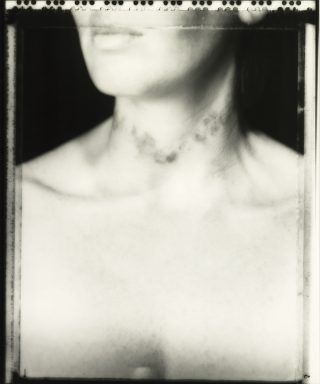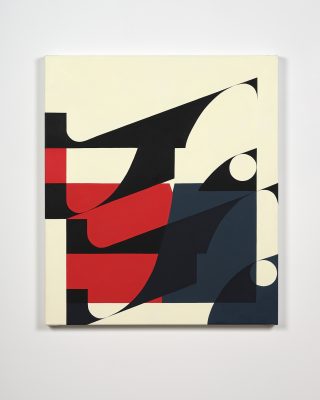Owen Connors
Owen Connors (born 1992) is a Tāmaki Makaurau-based artist and poet with an interest in the mystical, and in craft and cooperative making processes. Their superb 2019 exhibition, SISSYMANCY!, at play_station in Te Whanganui-a-Tara, comprised a series of patchwork and quilted banners. The works were intended to recall quilts produced collaboratively in commemoration of people who have died of AIDS-related illnesses. Although fabricated by Connors, they developed out of motifs provided by queer artists from around Aotearoa. The artists were invited to ‘draw a future world’ together, by engaging in a mail-based variation on the ‘exquisite corpse’ game (in which one participant draws part of a figure on a piece of paper, folds the paper leaving a few linking lines visible, then passes it on to another). The resulting banners—each with several interconnected bands of imagery—were suspended from rotating devices, which produced strangely melodious clicks and whirs. Standing still, you were presented with ever-changing pictorial conjunctions: a body of work consistently present but never at rest.
There was a certain coy evasiveness to SISSYMANCY! If you were attracted by a particular passage, you had to pursue it. Evasiveness is not uncommon in Connors’ work. Robbie Handcock—an organiser of play_station and contributor to the banners—recently reminded me that Connors’ 2016 poetry book, how to appear to disappear, was composed of black text on black paper. This is not to say that the artist is hiding things, exactly. Rather, they seem to be acknowledging complexity and multiplicity in communication, summoning those who wish to access their work not only to devote time, but also to accept irresolution. Recently, Connors has produced drawings in coloured pencil, presenting portraits of their friends at the online May Fair art fair, and images ‘derived from transmissions received in the presence’ of two AIDS-related memorials as part of DUIRVIAS, a duo show with Laura Duffy at Blue Oyster in Ōtepoti. The works are figurative, yet they remain tricky to read. Some are dream-like, while others are coded, nudge-and-wink—as things so often are in queer contexts, and among friends or chosen family.

Owen Connors, SISSYMANCY! (installation view), play_station, Te Whanganui-a-Tara Wellington, 2019. Photograph by Pippy McClenaghan.

Owen Connors, DUIRVIAS (installation view), Blue Oyster Art Project Space, Ōtepoti Dunedin, 2019. Photograph by Jonas Jessen Hansen.
Claudia Kogachi
Claudia Kogachi (born 1995, Awaji-shima, Japan) is based in Tāmaki Makaurau and represented by Sanderson Contemporary. Her works are typically cartoon-like in style—all planes of vibrant colour and dynamic body angles. They often centre on family, exploring aspects of the artist’s life story and cultural background, as well as more widespread phenomena. Her early paintings show pairs of blue-skinned women engaged in competitive and physical activities. Sometimes the figures appear in domestic spaces. They play soccer in the laundry, table tennis over breakfast, and box in a living room reminiscent of that on The Simpsons. The pieces are formally compelling, marked by awkward but wholly legible perspective and an enthusiasm for pattern. They overflow with energy. The women are strong, athletic, yet pleasingly unidealised. Their bodies are lumpy, armpits and legs frequently left hairy. At least two narratives are in operation. On the surface, competitors face off in various contexts. Beneath it, Kogachi and her mother quarrel. The works allude to a common experience: friction between child and parent.
In newer paintings, the artist addresses the personal more directly, reflecting on her Japanese-Hawaiian cultural heritage and including other family members. One piece shows her mother and obachan (grandmother) dressing her in her kimono. A relatively naturalistic work, currently on display at the Gus Fisher Gallery in Tāmaki Makaurau, depicts her late jiichan (grandfather) asleep in front of the TV in an All Blacks top. Earlier this year, Kogachi presented a series of rug-based works at play_station in Te Whanganui-a-Tara. These recreated clothes once worn by her jiichan, such as board shorts and a homemade ‘aloha shirt’ decorated with fans. Another rug, on show at Artspace Aotearoa in Tāmaki Makaurau, also centres on clothes. In it, a blue woman holds up a blouse next to a couch strewn with laundry. The blue is warmer than usual here, but the mood more sombre. At first, I want to read the figure as Kogachi’s mum, wearily folding washing. In fact, it is the artist herself, at work as a nanny. She now occupies the parental role. It’s a moving piece, and one that underscores her knack for blending the deeply specific and the oh-so familiar.

Claudia Kogachi in her studio, 2019. Photograph by Annamarie Ott.
Hulita Koloi
Hulita Koloi (born 1996) is a student at Whitecliffe College of Arts and Design in Tāmaki Makaurau. She recently co-curated a young artist show, WYF: Where You From, at Te Uru Waitākere Contemporary Gallery. I first became aware of her work as an artist when I was a judge at this year’s Eden Arts Art Schools Award. Koloi earned a highly commended prize for her presentation, Malaloi. The eponymous central work consists of a cube of scaffolding from which are hung 139 concrete-dipped garments. The clothing comes from many places, not only from around Aotearoa, but also from Fiji and Tonga. Koloi, who was born in Tonga but has lived here since she was three, used social media to put a call out to members of the wider Moana (Pacific) community, requesting ‘pieces that inspired pride for their cultures’. In bringing the items together and forging them into a monument, she celebrates the community, the collective effort of the gathering, and the individuals who once wore the clothes. The work is experientially rich. It initially appears as a monolith, rigid and imposing. Yet it is also inviting. Enter and you are enveloped, embraced.
Standing inside Malaloi, I thought of the sensation of being surrounded by racks in a crammed second-hand store and could almost smell that strangely universal scent of old clothing. A process of revelation took place as I began to pick up on patterns and logos discernible through the grey skin. The garments felt assaulted. They were not just dirty (off the sports field, say), but had been through a trial. I pictured clothes caked in sand on a beach—perhaps dropped off a nearby boat, perhaps having endured something worse, like a severe storm. I thought, too, of concreting as a job: tough work, hard on the body, and not always well paid. Concrete is, of course, central in present-day construction, particularly in urban environments, which can threaten homogenisation as they absorb people of diverse cultures. Koloi notes, ‘By layering the clothing in concrete, I hoped to emphasise the ever-growing separation from our cultures and faith at the hands of capitalism.’ Even without such information, Malaloi is perfectly articulate. Mournful and proud and drab and exquisite all at once, it’s a work by an exceptionally promising artist.

Hulita Koloi, Malaloi (installation view), Whitecliffe College of Arts and Design, 2019. Photograph by Madeleine Smith.
*
First published alongside profiles of Selina Ershadi, Matilda Fraser, and Aliyah Winter by Dilohana Lekamge in Index 1 (September 2020): 124–131. Republished as separate profiles by Art Paper.




